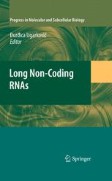Search
Search Results
-
Plant B Chromosomes: What Makes Them Different?
B chromosomes are dispensable elements that do not recombine with the A chromosomes of the regular complement and that follow their own evolutionary...
-
Xenopus Genomics and Genetics: Progress and Prospects
The amphibian Xenopus laevis has proved to be an outstanding model system for molecular, cell, and developmental biology, providing seminal insights...
-
Co-transcriptional architecture in a Y loop in Drosophila melanogaster
The Y loops of Drosophila spermatocytes are formed by the expression of huge individual transcription units on the Y chromosome and their large size...

-
RrS1-like Sequences of Water Frogs from Central Europe and Around the Aegean Sea: Chromosomal Organization, Evolution, Possible Function
RrS1 -like sequences of water frogs (genus Pelophylax ) display varied genomic organization, whereas the centromeric hybridization pattern reveals...

-
Subnuclear targeting of the RNA-binding motif protein RBM6 to splicing speckles and nascent transcripts
RNA-binding motif (RBM) proteins comprise a large family of RNA-binding proteins whose functions are poorly understood. Since some RBM proteins are...

-
Integrative map** analysis of chicken microchromosome 16 organization
BackgroundThe chicken karyotype is composed of 39 chromosome pairs, of which 9 still remain totally absent from the current genome sequence assembly,...

-
Probing the meiotic mechanism of intergenomic exchanges by genomic in situ hybridization on lampbrush chromosomes of unisexual Ambystoma (Amphibia: Caudata)
The meiotic mechanism of unisexual salamanders in the genus Ambystoma was previously explained by observing lampbrush chromosomes (LBCs). In...

-
Fibrillar actin in nuclear apparatus of ciliate Paramecium Caudatum
Ciliates are a good model for studying the role of actin in the nuclear spatial organization and transcription activity due to their nuclear dualism....
-
Cohesin proteins load sequentially during prophase I in tomato primary microsporocytes
Proteins of the cohesin complex are essential for sister chromatid cohesion and proper chromosome segregation during both mitosis and meiosis....

-
Fragmentation of coding region chromatin of trp-dioxygenase (to) and tyr-aminotransferase (tat) genes in their active and repressed states by micrococcal nuclease
The pattern of DNA fragmentation by mirococcal nuclease (MNase) of tyr-aminotransferase ( tat ) and trp-dioxygenase ( to ) genes in active (rat liver...
-
TBP-related factors: a paradigm of diversity in transcription initiation
TATA binding protein (TBP) is a key component of the eukaryotic transcription initiation machinery. It functions in several complexes involved in...

-
Transcription of Satellite DNAs in Insects
The very complex life cycle and extreme diversity of insect life forms require a carefully regulated network of biological processes to switch on and...
-
Two RNA Worlds: Toward the Origin of Replication, Genes, Recombination, and Repair
All modern organisms depend on genomes that encode a diversity of RNA molecules functioning in a plethora of physiological, regulatory, and...
-
Ovaries of Tubificinae (Clitellata, Naididae) resemble ovary cords found in Hirudinea (Clitellata)
The ultrastructure of the ovaries and oogenesis was studied in three species of three genera of Tubificinae. The paired ovaries are small, conically...

-

-
Lampbrush chromosomes enable study of cohesin dynamics
The lampbrush chromosomes present in the nuclei of amphibian oocytes offer unique biological approaches for study of the mechanisms that regulate...

-
Nucleocytoplasmic mRNP export is an integral part of mRNP biogenesis
Nucleocytoplasmic export and biogenesis of mRNPs are closely coupled. At the gene, concomitant with synthesis of the pre-mRNA, the transcription...

-
Rye B chromosomes are weakly transcribed and might alter the transcriptional activity of A chromosome sequences
B chromosomes (Bs) are dispensable components of the genomes of numerous species. To test whether the transcriptome of a host is influenced by Bs, we...

